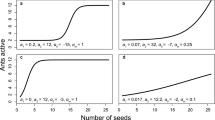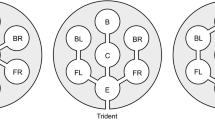Summary
The nest locations of two ant species in the Colorado Desert are intraspecifically overdispersed. Intraspecific overdispersion has been thought to represent strong intraspecific competition. Here we consider this hypothesis along with three competing hypotheses: microhabitat selection by foundress queens, predation on foundress queens, and predation on established colonies. To test these hypotheses five types of data were collected: (1) the forager population sizes of Veromessor pergandei and Pogonomyrmex californicus, (2) the response of the territory use of V. pergandei to varying levels of food, (3) the encounter rates of conspecifics and other ant species to foundress queens artificially placed near and far from conspecific colonies, (4) predation on colonies as a function of colony spacing, and (5) the relationship between the plant microhabitat at the nest and colony spacing. The results show that established colonies have no apparent selectivity for a particular type of plant microhabitat nor do foundress queens show avoidance or attraction toward conspecifics. V. pergandei workers show only a slight ability to find V. pergandei queens that are artificially placed near their entrances. Certain spiders are the most common ant predators on our study area. Direct observations on spiders indicate that colonies with closer neighbors are not prone to a higher risk of predation. In addition, the estimates of the death rate of workers from a mark-recapture technique indicate that colonies with closer neighbors lose similar numbers of workers as compared to colonies with further neighbors. In favor of the competition hypothesis, the summed size of intraspecific nearest neighbor pairs are larger for colonies that are spaced further apart than those colonies that are spaced closer together. We also develop an index of foraging directionality for the column foraging species V. pergandei. Using this measure, we find that nearest neighbors tend to avoid foraging toward each other. The response of territory use to food levels was tested with experiments involving patches of cracked wheat. These experiments showed that patches away from nearest neighbors were found significantly sooner than patches toward nearest neighbors. The above five sets of data together suggest that resource competition and perhaps queen predation by established colonies account for the intraspecific spatial patterns of these species.
Similar content being viewed by others
References
Bartz SH, Holldobler B (1982) Colony founding in Myrmecocystus mimicus Wheeler (Hymenoptera: Formicidae) and the evolution of foundress associations. Behav Ecol Sociobiol 10:137–147
Bray JR (1956) A study of mutual occurrence of plant species. Ecology 37:21–28
Burgess JW, Ralston D, Shaw E (1982) Territorial aggregation: An ecological spacing strategy in acorn woodpeckers. Ecology 63:575–578
Carlson DM, Gentry JB (1973) Effects of shading on the migratory behavior of the Florida harvester ant, Pogonomyrmex badius. Ecology 54:452–458
Chew RN (1979) Mammalian predation on honey ants, Myrmecocystus (Formicidae). Southwest Nat 24:677–682
Clark PJ, Evans FC (1954) Distance to nearest neighbor as a measure of spatial relationships in populations. Ecology 35:445–453
DeBruin MK, Rost LCM, Draisma FGAM (1977) Estimates of the number of foraging ants with the Lincoln-index method in relation to the colony size of Formica polyctena. J Anim Ecol 46:457–470
DeVita J (1979) Mechanisms of interference and foraging among colonies of the harvester ant Pogonomyrmex californicus in the Mojave Desert. Ecology 60:729–737
Elmes GW (1974) The spatial distribution of a population of two ants species living in limestone grassland. Pedobiologia 14:412–418
Erickson JM (1972) Mark-recapture techniques for population estimates of Pogonomyrmex ant colonies: An evaluation of the 32P technique. Ann Entomol Soc Am 65:57–61
Gentry JB (1974) Response to predation by colonies of the Florida harvester ant, Pogonomyrmex badius. Ecology 55:1328–1338
Gordon SA (1978) Food and foraging ecology of a desert harvester ant, Veromessor pergandei (Mayr), Ph.D. dissertation. University of California, Berkeley
Harrison JS, Gentry JB (1981) Foraging pattern, colony distribution, and foraging range of the Florida harvester ant, Pogonomyrmex badius. Ecology 62:1467–1473
Holldobler B (1970) Steatoda fulva (Theridiidae), a spider that feeds on harvester ants. Psyche 77:202–208
Holldobler B (1979) Territoriality in ants. Meetings of the American Philosophical Society pp 211–219
Holldobler B (1981) Foraging and spatiotemporal territories in the honey ant Myrmecocystus mimicus Wheeler (Hymenoptera: Formicidae). Behav Ecol Sociobiol 9:310–314
Parks HB (1929) The honey ant Myrmecocystus melliger at San Antonio, Texas. Bulletin Brooklyn Entomological Society 24:32–34
Pielou EC (1960) A single mechanism to account for regular, random, and aggregated populations. J Ecol 48:575–584
Porter SD, Jorgensen CD (1981) Foragers of the harvester ant, Pogonomyrmex owyheei: A disposable caste? Behav Ecol Sociobiol 9:247–256
Rissing SW (1981) Prey preferences in the desert horned lizard: influence of prey foraging method and aggressive behavior. Ecology 62:1031–1040
Ryti RT, Case TJ (1984) Spatial patterns and diet overlap between colonies of three desert ant species. Oecologia (Berlin) 62:401–404
Schaffer DT Jr, Whitford WG (1981) Behaviorial responses of a predator, the round tailed horned lizard, Phrynosoma modestum and its prey, the honey pot ant, Myrmecocystus spp. Am Midl Nat 105:209–216
Sinclair DF (1985) On tests of spatial randomness using mean nearest neighbor distance. Ecology 66:1084–1085
Wheeler GC, Wheeler J (1973) Ants of Deep Canyon. University of California, Riverside
Whitford WG (1978) Foraging in seed-harvesting ants Pogonomyrmex spp. Ecology 59:185–189
Whitford WG, Byrant M (1979) Behavior of a predator and its prey: The horned lizard (Phrynosoma cornutum) and harvester ants (Pogonomyrmex spp.). Ecology 60:686–694
Woodell SRS, Mooney HA, Hill AJ (1969) The behavior of Larrea divaricata (Creosote bush) in response to rainfall in California. J Ecol 57:37–44
Yeaton RI (1978) A cyclical relationship between Larrea tridentata and Opuntia leptocaulis in the Northern Mohave Desert. J Ecol 66:651–656
Yeaton RI, Cody ML (1976) Competition and spacing in plant communities: The Northern Mojave Desert. J Ecol 49:255–269
Author information
Authors and Affiliations
Rights and permissions
About this article
Cite this article
Ryti, R.T., Case, T.J. Overdispersion of ant colonies: a test of hypotheses. Oecologia 69, 446–453 (1986). https://doi.org/10.1007/BF00377067
Received:
Issue Date:
DOI: https://doi.org/10.1007/BF00377067




